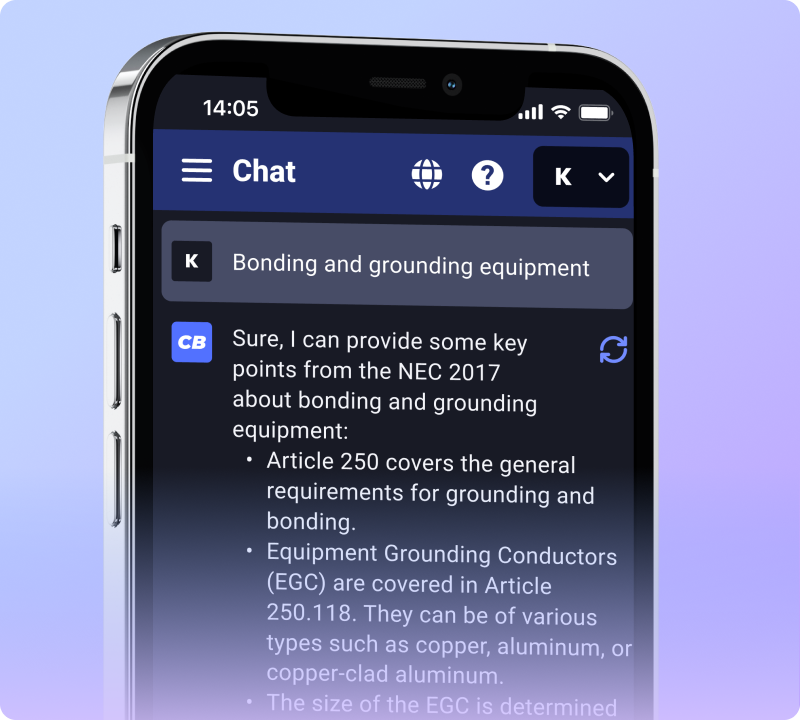Having trouble with electrical terms can make working on projects confusing. NEC Article 100 lays down definitions that clear up this confusion. This blog will guide you through these definitions, making it easier to follow safety standards in your work.
Keep reading for clarity.
Key Takeaways
- NEC Article 100 provides clear definitions for electrical terms, making it essential for safety and compliance in electrical work.
- Changes in the code, like the updated definition of “accessible” in 2020, show how important it is to stay current with NEC standards.
- Understanding terms such as “bonding jumper,” “adjustable speed drive,” and “grounded conductor” helps electricians install safe and efficient systems.
- The Authority Having Jurisdiction (AHJ) has a key role in applying these definitions, which can vary by location.
- Real-life examples include using GFCI devices in residential wiring to prevent shocks and understanding feeders and disconnecting means for industrial safety.
Overview of Article 100 NEC

Article 100 NEC gives definitions for electrical terms. It covers general and specific definitions for high voltage systems too.
General Definitions
The National Electrical Code (NEC) Article 100 provides clear definitions for terms electricians use every day. These include words like “ampacity,” which means the maximum current a conductor can carry without overheating, and “approved,” meaning acceptable to the Authority Having Jurisdiction (AHJ).
Terms such as “attachment plug” or simply “plug,” refer to a device that connects electrical equipment to an electric supply. The section on general definitions helps ensure everyone speaks the same language in electrical installations.
Definitions also cover key components of electrical systems such as “branch circuit,” the part that brings power to individual devices, and “conductor,” materials like copper or aluminum that carry electricity.
Other important terms include “continuous load,” a load where maximum current is expected to continue for three hours or more, and “cooking unit,” referring often to stoves or ovens in homes.
Knowing these terms allows electricians to effectively communicate with each other and comply with safety standards.
Understanding NEC’s basic terms is crucial for safe and efficient electrical work.
Next, let’s explore definitions specific to systems over 600 volts.
Definitions for Systems Over 600 Volts
Part II of the NEC focuses on systems that operate over 600 volts. This section is crucial because it covers installations and equipment designed for high voltage. Electricians working with power distribution, transmission lines, or large industrial electrical setups must understand these definitions well.
They guide how to safely manage electric power in heavy-duty applications.
Systems over 600 volts need special parts like surge arresters and grounding electrode conductors to ensure safety and efficiency. These components help prevent flashovers and protect against fault currents.
Overcurrent protective devices are critical too. They limit outages by keeping them within the affected circuit or equipment area only. Understanding these terms helps electricians install and maintain electrical systems that are safe, reliable, and compliant with codes.
Key Terms and Definitions
Understanding key terms and definitions in NEC Article 100 is crucial for professionals. It enables precise communication and accurate application of electrical codes.
Accessible (as applied to equipment)
The 2020 NEC® changed how we think about “accessible” in electrical work. Now, it means equipment must be easy to reach for operation, renewal, and inspection. Before this change, the term allowed for some confusion since it talked about not being blocked by locked doors or needing to climb to get there.
This clarity helps electricians and engineers know exactly how to set up things like switches, circuit breakers, and lighting systems so they can easily fix or check them without unnecessary barriers.
This rule makes sure that important parts of our electrical infrastructure such as overcurrent protection devices, low-voltage ceiling power systems, HVAC units, ballasts (for controlling lights), transformers (to change voltages), electronic power supplies (that feed electricity to devices), and Class 2 power sources (for lower voltage needs) are all installed in ways that make them simple to access.
Making equipment accessible improves safety because it can be regularly inspected and maintained with less hassle.
Adjustable Speed Drive
Adjustable speed drives control the speed of machinery, motors, and other electrical devices. They play a key role in electrical systems by matching the speed of equipment to the specific demands of the task at hand.
This improves efficiency and reduces wear and tear on equipment, leading to longer lifespans and lower maintenance costs.
For electricians and those working with electrical installations, understanding adjustable speed drives is crucial. These devices must be labeled and listed as outlined in NEC Article 100 to meet safety standards and performance requirements.
Correct installation ensures that adjustable speed drives operate effectively, making them essential for tasks that require variable motor speeds like pumps or fans in residential, commercial, or industrial settings.
Bonding Jumper
A bonding jumper is a vital piece of wire or metal that ensures all parts of an electrical system stay connected. This connection makes sure electricity flows safely back to the ground if something goes wrong, like a short circuit.
It’s like a safety net for your home or building, keeping everyone safe from electric shocks and fires. Electricians use bonding jumpers in many places, from your fuse box to where your power supply meets machines.
Bonding ensures electrical continuity and conductivity between metal parts.
This tool connects different sections of conduits or the metal paths that wires run through, making sure there’s a continuous path for electricity to follow, even if parts aren’t touching directly.
Think of it as holding hands in a line so no one gets lost – each part stays connected, ensuring the whole system works together smoothly. Whether you’re setting up lighting in a bathroom or wiring up communications equipment, using a bonding jumper correctly is key to meeting safety standards and making sure everything functions as it should.
Branch Circuit
Branch circuits are key parts of electrical wiring. They connect the last safety device that stops too much current to the outlets where we plug in devices. Think of them as the roads electricity travels from a city’s gate (the overcurrent device) to every house or shop (the outlets).
There are four main kinds: for appliances, for general use, for one item only, and multiwire ones. Each type serves a different purpose in homes and buildings.
Electricians work with branch circuits daily. They install them to power everything from lamps to large machines. Knowing the difference between appliance and general-purpose circuits helps electricians decide which wire and fuse sizes to use.
For example, an individual circuit might go straight to an air conditioner, while a multiwire circuit can handle multiple devices on different paths but shares a common neutral conductor.
This knowledge ensures safe installations that meet code requirements like those outlined in NFPA 70, preventing shocks or fires.
Building Official
Moving on from branch circuits, we focus on the Building Official’s role. This person must know many terms like demand factor and disconnecting means well. They check electrical systems in buildings.
They need to understand both simple and complex concepts such as continuous duty and varying operation. This knowledge helps them make sure everything is safe and follows the rules.
The Building Official also keeps an eye on things like effective ground-fault current path and electric power networks. Their job includes knowing about signs that use electricity, electric vehicles, and how lighting works without filaments.
For every electrical installation project, they ensure it meets safety codes using grounded conductors, grounding conductors, and more from NEC Article 100 Definitions.
Grounded Conductor
A grounded conductor is a vital part of any electrical system. It connects directly to the earth or to some conducting body that serves instead of the earth. This connection ensures safety by providing a path for fault current to flow to the ground, reducing the risk of electric shock.
The grounded conductor plays a key role in protecting people and equipment from electrical hazards.
In every wiring system, choosing the right materials is essential. For instance, using copper-clad aluminum conductors ensures good conductivity and safety in grounding applications.
Ground-fault circuit interrupters (GFCIs) rely on this effective grounding to quickly detect and interrupt circuit imbalances, preventing harmful shocks. Surge protective devices also need proper grounding to divert excess voltage away from sensitive electronics during sudden power surges.
Safety in electricity begins with understanding grounded conductors.
Next, we explore how these definitions apply specifically within residential wiring scenarios.
Applications of Article 100 Definitions
Apply Article 100 Definitions in various electrical settings such as residential, commercial, and industrial installations. Use these definitions to ensure compliance with codes and standards for safe and effective electrical systems.
Residential Wiring
In homes, electricians use Article 100 definitions to install safe and efficient electrical systems. They make sure switches and circuit breakers are easy to reach. This is important for safety in case someone needs to turn off power quickly.
Lighting, outlets, and appliances must connect correctly to avoid hazards like shocks or fires. For example, they install ground-fault circuit interrupters (GFCI) in bathrooms and kitchens where the risk of electric shock is higher due to water presence.
GFCI devices protect people by stopping the electricity flow if a fault is detected.
They also follow rules for how wires run inside walls, choosing the right types of conduit bodies and boxes that keep connections secure and protected from damage. Understanding concepts like branch-circuits helps them design layouts that distribute power evenly throughout a house without overloading any single circuit.
Electricians need this knowledge to ensure lights work properly and appliances receive enough power without causing short circuits or other problems.
Next, we explore commercial electrical installations.
Commercial Electrical Installations
Moving from residential wiring to commercial electrical installations, it’s crucial for electricians and electrical professionals to be mindful of the varying complexities in NEC definitions.
In this context, terms such as “accessible” and “continuous load” hold significant relevance when applied to commercial setups. As we navigate the ever-evolving world of electrical preferences and codes, understanding these definitions not only underpins safety but also ensures compliance with the necessary standards.
It’s vital that applications tailored towards commercial electrical installations are meticulously designed to enhance safety protocols and effective communication among professionals.
Understanding NEC definitions in commercial settings is crucial for ensuring safety and compliance.
Industrial Electrical Systems
As we shift our focus from commercial to industrial electrical installations, it becomes crucial to understand the significance of NEC Article 100’s definitions in this realm. Entities such as “feeder” and “disconnecting means” hold exceptional importance for industrial systems.
They form the backbone of safe and compliant operations within industrial facilities, ensuring a secure environment for the workforce and equipment. Additionally, the design of an effective ground-fault current path is imperative to carry current under ground-fault conditions, safeguarding against potential hazards.
Understanding these key concepts not only facilitates compliance with codes but also plays a pivotal role in enhancing safety measures across various industrial setups. Whether it’s residential wiring or commercial installations – same as when discussing feeder,” embracing a comprehensive understanding of these definitions ensures unwavering protection and operational efficacy.
Importance of Understanding NEC Definitions
Understanding NEC definitions is crucial for ensuring safety in electrical installations, enhancing compliance with electrical codes and facilitating effective communication among professionals.
Read more to delve into the significance of Article 100 NEC.
Ensuring Safety in Electrical Installations
Safety in electrical installations is paramount to prevent hazards and accidents. Understanding NEC Article 100 definitions is crucial for electricians as it underpins safety protocols and standards within the industry.
For example, the definition of “dead front” indicates equipment without live parts exposed to a person on the operating side, emphasizing the need for protective measures. Additionally, guarded equipment ensures protection from approach or contact by persons or objects to a point of danger, reducing the risk of accidents while working with electrical systems.
These definitions not only enhance compliance with electrical codes but also facilitate effective communication among professionals, ultimately ensuring safer electrical installations.
Furthermore, residential wiring examples can demonstrate how these definitions are applied in real-life scenarios for safer setups. It is essential to consider these key terms when undertaking any electrical installation project, ensuring that all appropriate safety measures are adhered to for both professionals and end-users’ safety.
Enhancing Compliance with Electrical Codes
To ensure compliance with electrical codes, it’s crucial to have a clear understanding of NEC definitions and their applications in residential, commercial, and industrial settings.
This understanding not only ensures safety but also facilitates effective communication among professionals involved in electrical installations. By being familiar with the key terms defined in Article 100 NEC, electricians can navigate the complexities of code requirements more effectively.
Additionally, this knowledge underpins the ever-evolving realm of electrical standards and regulations.
By having an in-depth grasp of these definitions along with the challenges in interpretation such as ambiguities in language and variations in enforcement, electricians can tailor their installations towards meeting stringent compliance requirements.
Ultimately, this deep understanding of NEC definitions aids electricians to design bespoke electrical systems that are not only safe but also align seamlessly with regulatory standards.
Entites from “Concepts” category: Article 100 NEC Definitions,
Entities from “Tools” category: Electrical codes
Facilitating Effective Communication Among Professionals
Clear definitions in the NEC Article 100 serve as a common language for electricians, ensuring effective communication. This facilitates precision in discussions about “grounding electrode” and “demand factor,” promoting industry-wide comprehension and uniform application.
Understanding these key terms reduces errors, enabling more efficient collaboration on electrical projects. For instance, when discussing “demand factor” during residential wiring or industrial applications, precise terminology enhances accuracy and safety measures.
Additionally, professionals can smoothly interact across different electrical realm by comprehending shared concepts like “bonding jumper,” minimizing misinterpretations that could lead to hazards.
Challenges in Interpretation
Interpreting electrical codes can be difficult due to language ambiguities, changing code editions, and variations in enforcement. These challenges are common in residential, commercial, and industrial applications alike.
Ambiguities in Language
Language ambiguities in the NEC definitions can lead to confusion and misinterpretation among electricians. For instance, the 2017 code language described “accessible” as allowing close approach without being guarded by locked doors, elevation, or other effective means.
However, the revised 2020 definition of “accessible” eliminates subjective terminology. Such shifts can create uncertainties in understanding and applying standards throughout electrical installations across residential, commercial, and industrial settings.
Furthermore, variations in language interpretation present challenges due to differing perspectives on key terms like “grounded conductor,” “bonding jumper,” and “building official.” The evolving nature of these definitions underscores the need for clear communication and a cohesive understanding within the industry to ensure consistent compliance with electrical codes.
Updates and Changes in Code Editions
The 2020 NEC® revised the definition of “accessible” in Article 100, impacting electrical installation practices. Additionally, code updates can alter how definitions are interpreted and applied, ensuring that electricians stay current with evolving standards and regulations.
These changes signify the ever-evolving nature of electrical codes, underscoring the importance of staying abreast of developments to uphold safety and compliance within electrical systems.
Variations in Enforcement and Application
The Authority Having Jurisdiction (AHJ) plays a crucial role in enforcing and applying NEC definitions. Different AHJs may have variations in how they enforce and apply the code requirements, leading to diverse interpretations.
This can result from factors such as regional preferences, historical practices, or even individual inspectors’ perspectives on compliance.
It’s imperative for electricians and electrical professionals to be aware of these potential variations in enforcement and application as they navigate through different jurisdictions.
Understanding these differences can help them ensure consistent compliance with NEC definitions across various locations, ultimately contributing to safer and standardized electrical installations.
Case Studies and Examples
Explore how NEC Article 100 Definitions are applied in residential wiring and industrial settings with practical scenarios. Delve into real-life applications to grasp the significance of understanding these definitions for safe and compliant electrical installations.
Residential Wiring Example
Residential wiring must include accessible overcurrent protection and GFCI devices. It involves defining the branch circuit and ensuring a grounded conductor for electrical safety.
For instance, understanding these definitions is crucial when installing GFCI devices in residential areas to prevent ground fault incidents.
In a residential setting, it’s essential to have a clear understanding of NEC Article 100 Definitions. For example, knowing what constitutes a branch circuit and the requirements for a grounded conductor can directly impact safety.
An important application of this is seen in the installation of Ground Fault Circuit Interrupter (GFCI) devices that protect against electric shocks in areas like kitchens and bathrooms.
Industrial Application Example
Industrial electrical systems rely on definitions such as “feeder” and “disconnecting means.” In these settings, effective ground-fault current paths are essential for ensuring safety and preventing hazards.
These systems often involve heavy machinery, high voltage equipment, and complex installations that demand strict adherence to NEC Article 100 Definitions to maintain a secure working environment.
Industrial sites should carefully interpret and apply these definitions to uphold electrical safety standards and prevent potential risks associated with the use of powerful equipment in their operations.
Conclusion
Understanding NEC Article 100 Definitions is crucial for electrical professionals. It ensures compliance and promotes safety in electrical installations. These definitions prevent misunderstandings and hazards, standardize terminology, and support uniformity in codes and regulations.
NEC Article 100 Definitions underpin the electrical industry’s operations and enhance safety standards.



